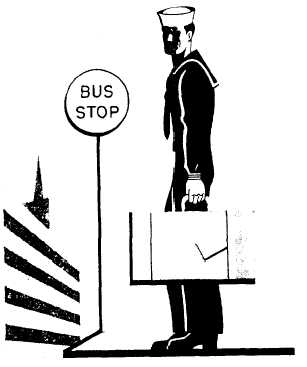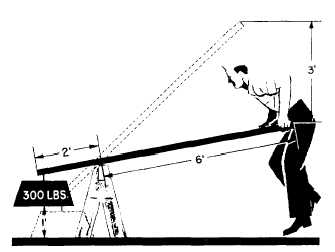Figure 7-3.—No motion, no work.
is doing 900 x 200, or 180,000 foot-pounds of work?
Of course not. He isn’t working against the pull of
gravity-or the total weight—of the load. He’s pulling
only against the rolling friction of the truck and that may
be as little as 90 pounds. That is the resistance that is
being overcome. Always be sure you know what
resistance is being overcome by the effort, as well as the
distance through which it is moved. The resistance in
one case may be the weight of the object; in another it
may be the frictional resistance of the object as it is
dragged or rolled along the deck.
2. You have to move the resistance to do any work
on it. Look at the sailor in figure 7-3. The poor guy has
been holding that suitcase for 15 minutes waiting for the
bus. His arm is getting tired; but according to the
definition of work, he isn’t doing any because he isn’t
moving the suitcase. He is merely exerting a force
against the pull of gravity on the bag.
You already know about the mechanical advantage
of a lever. Now consider how it can be used to get work
done easily. Look at figure 7-4. The load weighs 300
pounds, and the sailor wants to lift it up onto a platform
a foot above the deck. How much work must he do?
Since he must raise 300 pounds 1 foot, he must do
300 x 1, or 300 foot-pounds of work.
Figure 7-4.—Push’em up.
He can’t make this weight any smaller with any
machine. If he uses the 8-foot plank as shown, he can
do the amount of work by applying a smaller force
through a longer distance. Notice that he has a
mechanical advantage of 3, so a 100-pound push down
on the end of the plank will raise the 300-pound crate.
Through how long a distance will he have to exert that
100-pound push? If he neglects friction, the work he
exerts on the machine will be equal to the work done by
the machine. In other words,
work put in = work put out.
Since Work = Force x Distance, you can substitute
Force x Distance on each side of the work equation.
Thus:
in which
FI =
s, =
Fz =
S2 =
effort applied, in pounds
distance through which effort moves, in feet
resistance overcome, in pounds
distance resistance is moved, in feet
Now substitute the known values, and you get:
IOOXSI=300XI
S1 = 3 feet
The advantage of using the lever is not that it makes
any less work for you, but it allows you to do the job
with the force at your command. You’d probably have
some difficulty lifting 300 pounds directly upward
without a machine to help you!
7-2




